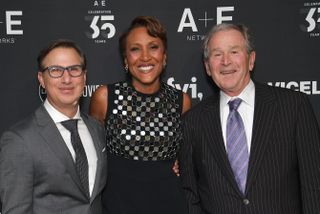Virus Has Ad Sales Execs Taking Day-By-Day Approach

Television network ad sales executives said they are taking a day-to-day approach as some advertisers pull their campaigns, others quickly change the commercials they’re airing and other push commercials they’d planned to air in March and April back to later in the year.
At this point, it’s hard to calculate how much ad revenues were lost in the first quarter due to the coronavirus outbreak, executives said. As the second-quarter starts, they expect more of the same with a key milepost coming about May 1, when advertisers who bought third-quarter commercials in the upfront can exercise options to cancel those orders.
Even more uncertain is the 2020-21 upfront. Live presentations have been canceled and networks are looking for new ways to make their upfront pitches to media buyers and clients. But it is unclear when marketers will be able to decide how much they want to spend on advertising with consumers stuck at home and many businesses closed to stop the spread of the virus.
“We're trying to have the philosophy of taking things two weeks at a time not to get too far ahead of ourselves and make decisions on where things are going to be a month or two from now,” said Peter Olsen, executive VP for ad sales at A+E Networks. “Everyone's been really reasonable. The conversations have been very understanding on both sides.”
At Crown Media, which runs the Hallmark Channel, advertisers in the hardest-hit categories including cruise lines, airlines and hotels move quick to cancel their ads as consumers were urged to stay home, said Ed Georger, executive VP for ad sales.
WORKING WITH ADVERTISERS
Other advertisers have taken different approaches. “They want us to work with them in a variety of ways. Some advertisers just want to push bank their schedules a little bit. Others may want to have broader shifts into other quarters. We've worked with people. We've had people donate their time to charitable organizations. We've been working with the Red Cross for example, and the Ad Council," Georger said.
Broadcasting & Cable Newsletter
The smarter way to stay on top of broadcasting and cable industry. Sign up below

Most clients are taking a day to day approach, looking at their own businesses and how the crisis is affecting their relationship with consumers.
“I think the more that we see advertisers adjusting their message and thinking about their business more long-term the less we're going to see the desire to just outright cancel," Georger said.
In the meantime, networks are doing business in the scatter market, where some advertisers are buying ads. Georger added that there’s a need for inventory for direct-response ads, although that market is soft because there is so much supply with traditional demand down and viewing up.
Hallmark is also looking to increase its own promotion with some of the ad inventory it has on its hands.
“We think that there's value in some messaging that we would do as a network to give support and encouragement to our viewers,” Georger said. “We're working with Hallmark cards to create a branded campaign that will really support the viewers and let them know that you know, as as a network, we're there for them and remind them of some of the positive things in their lives. It's a message the Hallmark brand is uniquely able to deliver."
Related: Hallmark Channel Launches Ads Thanking 'Frontline Heroes'
Media buyers are also busy accessing their clients’ needs and trying to figure out how to reach consumers as TV networks are forced by the crisis and the benching of live sports big changes in their programming lineups.
HOW LONG WILL IT LAST?
“Across categories and industries, there are a variety of reactions and explorations from cancellations, to postponements to creative re-expressions. To make a meaningful forecast on scatter and options, in general, there are two components that need to be clear: how definitively and quickly brands will respond and second, how extended the crisis will last,” said Matt Sweeney, U.S. chief investment officer at GroupM.
“With that said, we are confident there are and will be viable investment alternatives, and these alternatives could open different doors and paths to engage with customers. We are in dialogue with clients and partners daily, and it’s assuring to see the elevated collaboration,” said Sweeney.
Media agency Magna recently forecast that national advertising revenue will drop 13% this year, hurt by the Coronavirus crisis, with most of the decline occurring in the first half.
The network ad sales departments have had to figure out how to function from home, with offices close to slow the spread of the virus.
“I give kudos first of all to our IT department. They jumped into action and really got everyone in the company set up pretty quickly to be able to function from outside the office,” Georger said. With clients changing schedules and what commercials they want to run, traffic departments are also carrying the load.
“I tip my hat and give large praise to the traffic department and the IT department that equipped them and gave them the ability to be able to do their job,” Georger said. “It's the beginning of the quarter which is always a pressure time, but now you add to that the constant adjusting of schedules. They're doing an amazing job.”
“The traffic guys are the heroes right now. They're working like crazy right now,” added Olsen.
Olsen said that by approaching the business in two-week increments, the company has been able to put some guardrails around the fallout.
“There’s definitely an element of business as usually going on,” said Olsen. Some advertisers are buying in the scatter market. “There’s certain categories that are seeing minimal disruption and then clearly there are some that are dealing with very acute challenges.”
THIRD-QUARTER OPTIONS
The next inflection point that will determine how much ad sales will be disrupted in the second half of the year comes about May 1, which clients can start to exercise the options to drop the commitments to buy advertising in last year’s upfront.

“I think by then we'll have a better feel for what the third quarter's going to look like,” said Olsen. “Hopefully we'll just know a lot more at that point on the state of things.”
The options process will give “a strong indication of whether they want to advertise their way out of the slump or whether they'll adjust and take options,” Georger added.
This year’s upfront is also likely to be very different from the last few years. The glitzy presentations have already been canceled and the string of double-digit price increases on a cost-per-thousand viewers (CPM) basis is unlikely to continue. Some execs are looking at volume dropping like it did after 9/11 and the 2008 financial crash.
A+E canceled its upfront event, originally scheduled for March 25. Crown Media, which has had a big dinner event at the Rainbow Room for upfront advertisers in the past few years, this year had planned to make its pitch in a series of smaller meetings with agency buyers and clients.
Georger said that because it had already planned and scheduled meetings with clients, it might have had a bit of an advantage in delivering.
“Our upfront presentation was done and ready to hit the streets by the end of February. So we were well underway in getting in to see our clients and started starting to position ourselves,” he said.
Having meetings already on busy buyers’ schedules was also a plus. Crown is using Zoom and other video-conferencing technology and has been getting good attendance and attention.
THE NEW UPFRONT
Crown planned to base its pitch around its traditional strength of offering family-friendly programming and big events around the holiday that draw high ratings, especially in the fourth quarter around the Christmas season. Crown for the first time will be selling general advertising it its Hallmark Drama channel, which is now in 30 million homes.
For this upfront, Crown is also presenting research that shows how Hallmark programming appeals to an audience looking for an escape. Those viewers are engaged, and that benefits the advertisers, the research shows.
“Obviously like everyone else we've had to make the adjustment and you know social distance ourselves, but the presentation goes on,” Georger said. ”We've fine-tuned it and we've made it a point to be sensitive to their time and sensitive to the world that we're all living in. We're really letting them know that we're here for them, that we have opportunities when they're ready.”
A+E has boiled down the presentation it was planning to make into a 25-minute tape hosted by president Paul Buccieri. The tape focuses on the strategies of the company’s big three brands--A&E Network, History, Lifetime--and some upcoming programming. It features the networks’ A-list talent as well as its audience targeting technologies and guarantees based on business outcomes.
“We’re giving our sales force the discretion to roll it out over three or four weeks,” said Olsen.
A+E’s message also the pro-social work its doing by donating cash and airtime for groups like Team Rubicon, the American Red Cross, the Ad Council/CDC initiative and the Keep Kids Learning Fund. The company’s PSAs carry the @HereForYou tag.
“The reason we wanted to still put this message out is a belief that things will turn the corner, they will get back to some semblance of normal,” he said. “We wanted to let people know that when the time is right, category by category, client by client, we will start to engage in those longer-term conversations.”
Olsen said that the networks won’t be able to dictate when upfront negotiations will take place. But he expects there to be an upfront market.
“They still see value in the upfront. They want to secure their inventory and they’ll want more flexibility,” he said. “The idea that on May 1st of 2020, they're going to have a really firm grasp on. their needs from October of 2020 September of 2021 feels a little more outlandish than normal.”
In a normal year, Olsen notes, networks would now be in the middle of upfront related conversations, generating ideas for sponsorships and reaching specific audience targets. “Those are all kind of on hold. while we're just dealing with more like triage,” he said.
“You have to be careful that you're not being overly 'salesey' at a time when everyone was trying to figure out how to navigate these choppy waters,” Georger said.
Jon has been business editor of Broadcasting+Cable since 2010. He focuses on revenue-generating activities, including advertising and distribution, as well as executive intrigue and merger and acquisition activity. Just about any story is fair game, if a dollar sign can make its way into the article. Before B+C, Jon covered the industry for TVWeek, Cable World, Electronic Media, Advertising Age and The New York Post. A native New Yorker, Jon is hiding in plain sight in the suburbs of Chicago.

